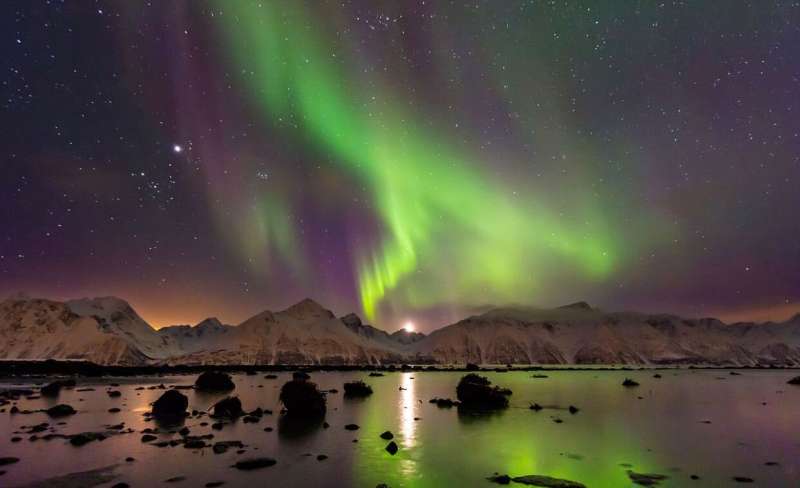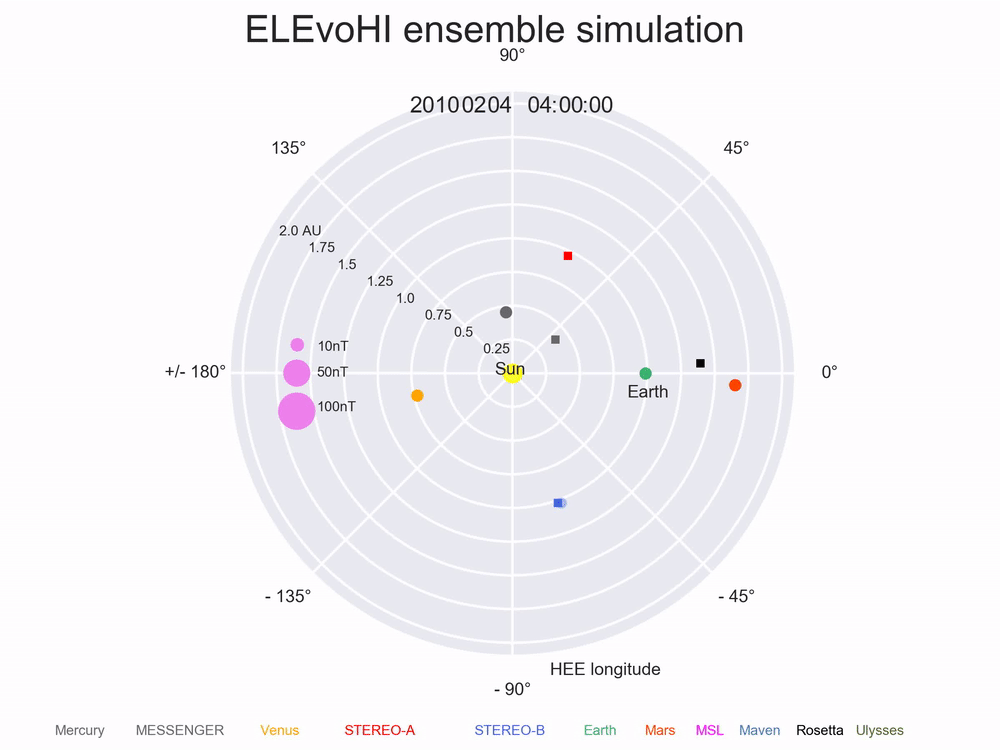Solar winds provide amazing effects with the aurora borealis. In case of solar storms, the consequences can be dramatic. Credit: Carsten/CC BY 2.0
A research group from Graz investigated how solar storms can be simulated in order to enable a more accurate prediction of their effects on the Earth. Their work has furnished a more accurate model for simulating solar storms in real time.
The sun is an extremely active star that has an impact on the planets of the solar system in many different ways. One of the most visible effects is aurora borealis. These northern lights are caused by solar wind, i.e. a steady stream of protons and electrons emitted by the sun, which interacts with the Earth's magnetic field and causes the colorful light effects. Under normal circumstances, the Earth's magnetic field largely shields the planet from the solar wind, but sometimes, huge flares erupt on the sun, hurling a great deal of hot material into space in a relatively short time. This material hits the Earth a few days later as a solar storm, which can damage satellites, disrupt GPS navigation or even cause power cuts. What, exactly, is involved in these events is still largely unknown, which is why several space probes carry instruments on board to record solar storms from outer space.
A research group headed by the astrophysicist Christian Möstl from the Graz-based Space Research Institute of the Austrian Academy of Sciences is working on a series of projects funded by the Austrian Science Fund FWF to model solar storms and their effects on Earth in real time, thus making it possible to predict such extreme events with greater precision. In a project completed in 2019, a team led by Möstl developed a particularly detailed model for the propagation of solar storms.
Elliptical shape
"The objective is unequivocal—we want to predict solar storms," says Christian Möstl. "There are several space probes that can track solar storms at some distance from Earth. In the 1990s, the SOHO probe was the first to make such recordings, today there is also the Parker Solar Probe and two further probes going by the name of STEREO." All these probes move in or near the ecliptic—the plane in which the planets orbit around the sun. What the storms look like from outside this plane cannot be ascertained with the current probes. The models need to work on the basis of assumptions that are as realistic as possible. "Older models assumed a dot-shaped or circular structure, but that's unrealistic," notes Möstl. "In an earlier project, we replaced the circles with circular arcs. In the recent project we have now taken the next step and used an elliptical shape."
In order to further increase accuracy, Möstl's team added a number of effects to the model. Solar wind usually has a lower speed than the solar storms and slows them down. "Solar storms react strongly to solar wind," Möstl explains. "Our new model is the first to combine STEREO's wide-angle observations with the drag effect created by the solar wind."
Simulation of a solar storm. The model enables predictions to be made in real time. Credit: Christian Möstl/IWF
Real-time simulation
The model has the special feature of being able to produce real-time forecasts as soon as suitable data is available. Such data could be furnished in the mid-2020s by a scheduled ESA satellite mission, as Tanja Amerstorfer, a member of the project team, points out: "It's not about reproducing the effects retrospectively, but about having a tool that we can use in real time." As a rule, solar storms take four or five days to reach the Earth. "The record speed is 14 hours," says Amerstorfer—enough time for an early warning system. At present there is, however, no official body for predicting when solar storms will hit the Earth. "There is a website where research groups like us can place bets on the time of arrival," says Möstl. In 2011 they participated and won, but he makes it very plain that this is not a serious warning system.
Consequently, a functioning early warning system is still lacking. "There have been several solar storms in history that would cause great damage today," says Amerstorfer. The last major event of this kind was in 1989 in Quebec, where it involved power cuts. In 1859 and 1921 even larger solar storms hit the earth. At that time, polar lights were even visible in middle latitudes, for example in Rome. Telegraph lines were damaged by that event. On today's infrastructure, such events would have devastating effects. "The U.S. and Great Britain have included this scenario in their national disaster plans," reports Amerstorfer. In 2012, a solar storm of the order of magnitude of the 1859 event just barely missed the Earth, incidentally.
Magnetic field as a problem
Möstl and Amerstorfer stress that there is still much to be done before a reliable warning system can be established. The error in estimating the time of arrival is currently at best around ten hours. According to Möstl, the biggest unsolved problem is the magnetic field in solar storms. "We know that these fields take the form of large, curved so-called "flux tubes." But we can only hypothesize about how exactly the field is configured in these tubes. It will be important to know the nature of the magnetic field in a solar storm."
According to Möstl, this is just as important as the size of the storm: "The direction of the magnetic field works like a switch. If the magnetic field of the storm has the opposite orientation to that of the Earth, it will transfer much more energy to the Earth's magnetic field than if it has the same orientation." Speed also plays a major role: a short, fast storm has a stronger effect than a slower, longer one. Moreover, solar storms often do not occur as a single event, but may immediately follow upon each other and interact with each other.
Simulate the whole chain of effects
In subsequent FWF projects, the Graz research group is now working on different aspects of the problem in order to build up a whole chain of simulations. "We want to combine everything in one model, from the eruption of the solar storm to the effects on Earth, the auroras and currents in the ground. That's the goal," says Möstl.
More information: T. Amerstorfer et al. Ensemble Prediction of a Halo Coronal Mass Ejection Using Heliospheric Imagers, Space Weather (2018). DOI: 10.1029/2017SW001786
C. Möstl et al. Forward Modeling of Coronal Mass Ejection Flux Ropes in the Inner Heliosphere with 3DCORE, Space Weather (2018). DOI: 10.1002/2017SW001735
Christian Möstl et al. Strong coronal channelling and interplanetary evolution of a solar storm up to Earth and Mars, Nature Communications (2015). DOI: 10.1038/ncomms8135
Journal information: Nature Communications
Provided by Austrian Science Fund (FWF)
























